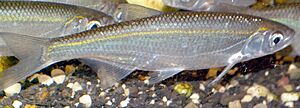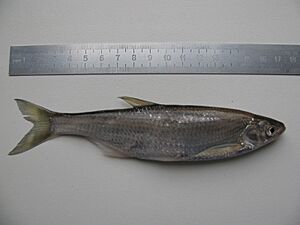Common bleak facts for kids
Quick facts for kids Bleak |
|
|---|---|
 |
|
| Conservation status | |
| Scientific classification | |
| Genus: |
Alburnus
|
| Species: |
alburnus
|
| Synonyms | |
|
|
The common bleak (Alburnus alburnus) is a small, shiny freshwater fish. It belongs to the carp family, which includes fish like carp and minnows.
Contents
What Does a Bleak Look Like?
The bleak has a long, flat body. Its head is pointy, and its small mouth points upwards. It has a long fin on its underside called the anal fin, with 18 to 23 rays. A special line along its side, called the lateral line, runs all the way from head to tail.
Bleak fish are very shiny and silvery. Their fins are clear and pointed. They can grow up to about 25 cm (10 inches) long.
How to Tell Bleak Apart from Other Fish
In Europe, it can be tricky to tell a bleak from other young fish. For example, young common bream and silver bream might look similar. However, the bleak's pointy, upward-turned mouth helps to identify it, even when it's young. Young roach and ruffe have wider bodies and shorter anal fins, which makes them different from the bleak.
Where Do Bleak Live?
You can find bleak fish in Europe and Western Asia. They live north of the Caucasus, Pyrenees, and Alps mountains. They also live eastward towards the Volga river basin in northern Iran and north-western Turkey.
Bleak are not naturally found in the Iberian (Spain and Portugal) or Apennine (Italy) peninsulas. They are also absent from rivers that flow into the Adriatic Sea in the Balkans, and most of the British Isles, except for southeast England. However, they have been introduced to some places in Spain, Portugal, and Italy by people.
How Do Bleak Live?
Bleak fish live together in large groups called schools. They eat small molluscs, insects that fall into the water, insect larvae, worms, tiny shellfish, and bits of dead plants. You can find them in both streams and lakes.
These fish prefer open water areas. They are often found in large numbers where there is a lot of food coming in, such as near pumping stations or behind weirs (small dams).
How Do Bleak Reproduce?
Common bleak usually become old enough to have babies when they are about three years old. They lay their eggs from April to June, when the water temperature is around 14 to 15 °C (about 58 °F).
A female bleak can lay between 5,000 and 7,000 eggs in several batches. She places these eggs on plants underwater or in shallow parts of the water. During this time, male bleak develop small bumps called nuptial tubercles on their backs and sides. Their fins also turn an orange color. The eggs hatch after about 2 to 3 weeks.
The young fish, called fry, grow slowly. They mainly eat tiny floating organisms called plankton. Sometimes, bleak can even have babies with other types of carp-like fish, such as Chub, Roach, Rudd, or Bream.
Why Are Bleak Important?
Bleak are an important food source for bigger predatory fish. They are more sensitive to pollution than other fish in the carp family. This might be why their numbers have gone down in north-western Europe.
How Are Bleak Used by People?
People sometimes use bleak as bait when they are fishing for larger fish. In 1656, in Paris, a man named Mr. Jaquin discovered how to get something called essence Orientale or "pearl essence" from bleak scales. This substance is made of tiny crystals called guanine, and it was used to make artificial pearls.
Images for kids




